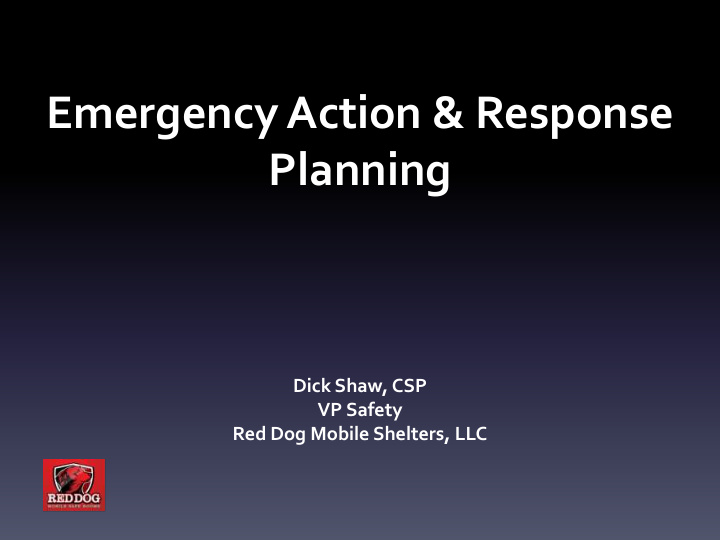



Emergency Action & Response Planning Dick Shaw, CSP VP Safety Red Dog Mobile Shelters, LLC
Hazards • Vehicles Accidents • Active Shooter • Injuries & Fatalities • Environmental • Weather • Power Loss • Fire & Explosions • Terrorist • Earthquake • Disease
Do Any Of These Look Familiar?
Emergency Action Planning Cycle
Consequences! – The Media – The Public – Regulators – Insurance Costs – Production – Future Contracts
Preparedness
Preparedness Minimum Requirements for a Written Plan: – OSHA 1910.38; 1026.35; and … – Section 5(a)(1) General Duty Clause – API 49 7.3-8; 68 7.3-9 “Written plans are worthless if they are too complicated to implement in an emergency!”
Preparedness Written Plans must include: Reporting procedures • Evacuation, Exit Route, and Critical Duties procedures • Shelter-in-Place procedures • Muster Point and Accountability procedures • Rescue & Medical procedures • Training Plans for All Employees – Practice Drills • Program audit procedures • Plans must be written for each worksite. Not one size fits all.
Preparedness Written Plans must : • Cover all potential hazards • Be specific to each unique work site; and • Be easy to understand and implement • Sample Plan
Preparedness A thorough Hazard Assessment for each worksite is the key to a successful plan. You have 3 options for most Emergency Responses 1. Do Nothing – Wait and See What Happens 2. Evacuate to a safer place 3. Shelter-in-Place
Preparedness Best Ways To Prepare: • Drill on Your Procedures • Learn from Others • Coordinate Resources and Drills with Stakeholders (company, subs, communities, etc.)
Response
Response At that moment, how do you handle the event?
“Dude, Where Do We Go?”
Response Plan must have Critical Actions & Directions • Communication Links and Capability • Command & Control • Rescue and Medical Treatment • Damage Assessment • Outside Resources Coordination • Media Control • Response Plan to Management w/ Targets
How Long Does a Response Last? Until Recovery Begins!
Recovery
How Do You Know When Recovery Begins? • Days/Weeks/Months/Years • Production back on line (drilling, completion, production, construction, etc.) • Media Losing Interest (news cycle, articles, internet blogs, etc.) • Lawyers Showing Interest • Regulators Showing Interest
Mitigation
What is Mitigation? • Mitigation is the effort to reduce the loss of life and property by lessening the impact of disasters in the future.
Value of Mitigation? • Creates Safer Work Sites and Communities • Speeds Recovery Process • Saves Money
Key Activity - After Action Review • What Happened? • What Went Well? • What Needs to be Improved? • Objectives, Assignments, and Time Tables • Follow Up with Top Management
Value - After Action Reviews • Creates detailed action plans w/ dates • Creates metrics for management reviews • Gives speaking points to media • Provides credibility to Regulators and Insurance Companies • Keeps Employees Informed • Institutionalizes Key Learnings for Organization
Case Study? Tornado • Anchoring of Rig Site Shelter–in-Place
5/22/11 Cactus Drilling Rig #117 Oilwell 860E - • Rated at 1500 HP. • 142’ Derrick • 1 Million pounds static hook load. • 30’ Floor Height 8 Miles West of El Reno, OK
Cactus Rig #117 5/23/11
Front Anchors Snapped, Rear Held
When anchors snapped, Shelter-in-Place was partially airborne. Rear anchors held.
Up Lift Overturn Skid (+) Skid (-) Tornado Shelter Design Energy absorption Understanding wind loads (massive impacts)
Uplift It is obvious that a At 350 mph… box-like house with six, 10,000 # anchors What are 85,800 #’s can not withstand such Wind forces the physics? Windward Leeward 8,300 lb. Std Conex box 99,000 #/s Sliding Overturning 8,300 #’s 700,000 ft-lbs min 10,000 # 10,000 # anchors anchors
Uplift Aerodynamic 39,800 #’s As wind speed increases these Forces generated by dual internal 14” Vacuum tubes Anchoring turns 350 mph wind cause dynamic equalization of the the destructive static pressure at the roof apex impacting long side force of the wind with the pressure inside the The wind accelerates as it into a stabilizing enclosed “basement” area of the passes over the top creating shelter thus forcing the safe room force: “wing lift” (negative pressure) downward. The Faster the that “aspirates” air from beneath the floor. This causes Wind the MORE a vacuum beneath the floor stable the shelter that is much greater than the uplift. This vacuum “forces” the unit downward preventing movement in any direction. Leeward Windward 41,000 #’s 113,400 #’s Sliding Overturning is negative 73,000 #’s Friction *US Patent 8,136,303 185% Safety Factor and 8,245,450 and 8,375,6 42 and other Patents Pending
Key Findings from Mitigation Analysis • Having an Emergency Response Plan is Good • Providing Shelter-in-Place is Necessary • Mechanically Anchored SIP is inadequate • New Anchoring Technology exists • Aerodynamic Anchoring of SIP is better
Conclusion • Emergency Response Plans Are Essential • Each phase drives towards “Response” • Evaluation, Training, and Drills Pay Off • Keep An Eye On Technology
• Questions? • Comments? • Concerns?
Red Dog Anchorless Multipurpose Safe Rooms
Recommend
More recommend